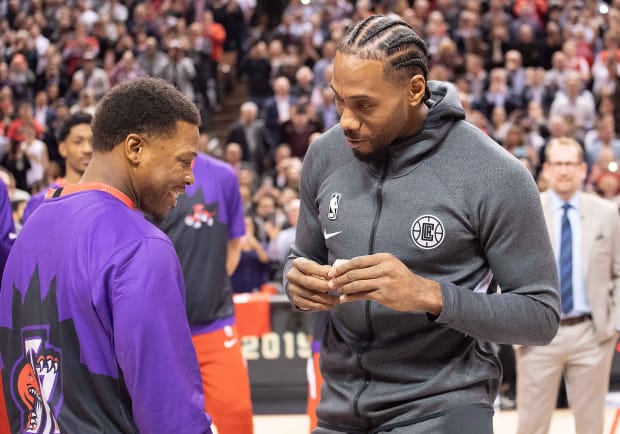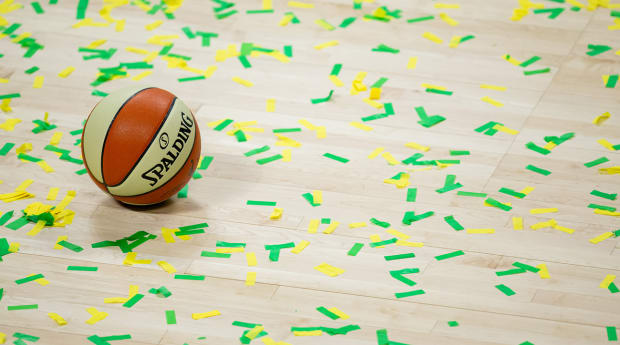After crafting the Raptors' massive championship ring, the makers behind the bling have big plans for the Seattle Storm.
Raptors point guard Kyle Lowry had specific instructions for Toronto’s championship ring after the franchise’s first championship in June 2019: The flashier the ring, the better.
“Kyle came to us with a real vision in mind,” says Baron Championship Rings president Peter Kanis. “He wanted his ring to be a show piece, to be unlike any other ring in championship history.”
Kanis and Baron delivered on Lowry’s request. In partnership with Rick Antona at Uptown Diamond in Houston, Baron created what is now considered the crown jewel of championship rings. The Raptors’ title bling sports a record 650 diamonds along with an unmatched 15 carats of diamond, setting a new standard in the championship ring marketplace. But Toronto’s ring wasn’t solely the product of Lowry’s creativity. For Karis and Antona, the ring represented an achievement in the industry, serving as the culmination of a near decade-long process of innovation.
“It was a work of art,” Antona says. “An absolute work of art.”

Championship rings aren’t exactly a novelty in the world of sports. The first championship rings date back to the late 19th century, when the Montreal Hockey Club received what resembled a wedding band after their 1893 championship. And while the rings grew in size and glamour over the course of the 20th century, the process for creating them remained relatively stable. Ring producers relied on hand-drawn models of the rings along with molds of various hand sizes, creating an inexact science for both the producers and teams alike. But recent innovations have changed the ring-making game altogether. With the use of 3D printers, the design and production of title rings has been expedited, creating a world of possibilities.
“Up until about five, six years ago, a majority of championship rings were hand drawn in their early stages. We were the first company to actually do a full 3D printed championship ring,” Kanis says. “And now every ring begins with some form of 3D component. With 3D modeling, whatever you can design, you can create. When we’re competing for a championship ring, we send a 3D model, and it’s pretty much perfect. It allows us to present a much more detailed product.”
Kanis and Antona began their foray into 3D modeling nearly a half-decade ago, starting with quite the high-profile client. The ring-making duo used their 3D technology on the Cavaliers’ championship ring, allowing them to continually re-design the ring after receiving notes from owner Dan Gilbert and other members of Cleveland’s front office. Such flexibility is necessary in the championship ring business. Presenting a single prototype is far from sufficient. To truly catch the eye of team management, there needs to be a wide array of options.
Kanis and Antona’s business requires more than the right technology. The duo often battles numerous companies for the right to design a certain championship ring, leading to a stream of pitch meetings with owners, management and players. This stage is often the most critical. Kanis stressed the need for both creativity and flexibility, noting his reliance in storyboards in the presentation stage. Many companies can design and produce a championship ring. Connecting with a client is a more complex task.
“Typically when we create a championship ring, we start with a storyboard,” Kanis says. “We create all the points of the championship, whether it be sayings, mottos, the team’s record. We write down about 30 to 40 ideas and then create multiple ring designs. We go into a presentation with at least four different ring designs.”
Kanis and Co.’s creativity is evident in the Raptors’ championship ring. Not only is the ring historic on the merits of its weight and diamonds, it’s also one of the first to be heavily personalized. The Toronto skyline is featured in the ring, as is the team’s “We the North” motto. Toronto’s ring also features six circular diamonds to represent the city’s nickname, adding a nod to the Raptors’ most famous fan. For Kanis and Antona, a championship ring doesn’t just celebrate a championship. It tells the story of a team and its bond with a city.
“It’s more than just another piece of jewelry,” Antona says. “When players or staff members or even certain fans receive our rings, they’re reminded of that championship feeling. It can provide a lot of joy just seeing one up close.”

Baron and Uptown Diamond aren’t the only designers and producers in the championship ring market. Title teams will take pitches from as many as a dozen companies before deciding on a manufacturer, and in a pinch, desperate times call for desperate measures. Antona has sent teams more than his fair share of $3,000 cakes. Karis has created nearly a dozen models for the same client. As companies claw for exclusive rights to a given team, persistence is paramount. The maniacal push to land a championship ring deal often resembles a team fighting to win the Finals or Stanley Cup.
Kanis missed the opportunity to land his second straight Finals winner in October as the Lakers opted for a local jeweler. But he and Antona are currently working on another high-profile client. The duo has been tasked with creating the Seattle Storm championship rings, and while the official designs have yet to be released, there is a palpable excitement for their follow-up to Toronto’s title. The nation’s foremost ring innovators have something special up their sleeve for the reigning WNBA champs.
“This one is gonna look a little different from what you’ve seen in the past,” Kanis says. “We like where this is going.”